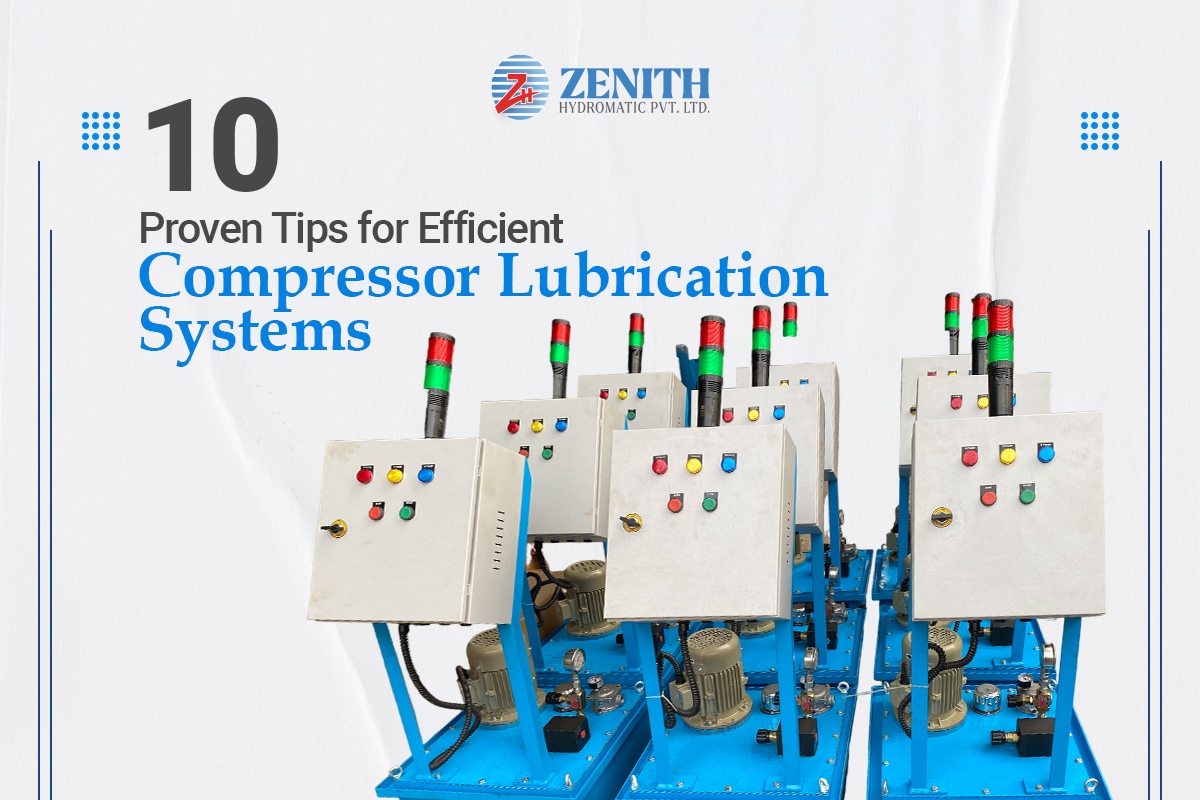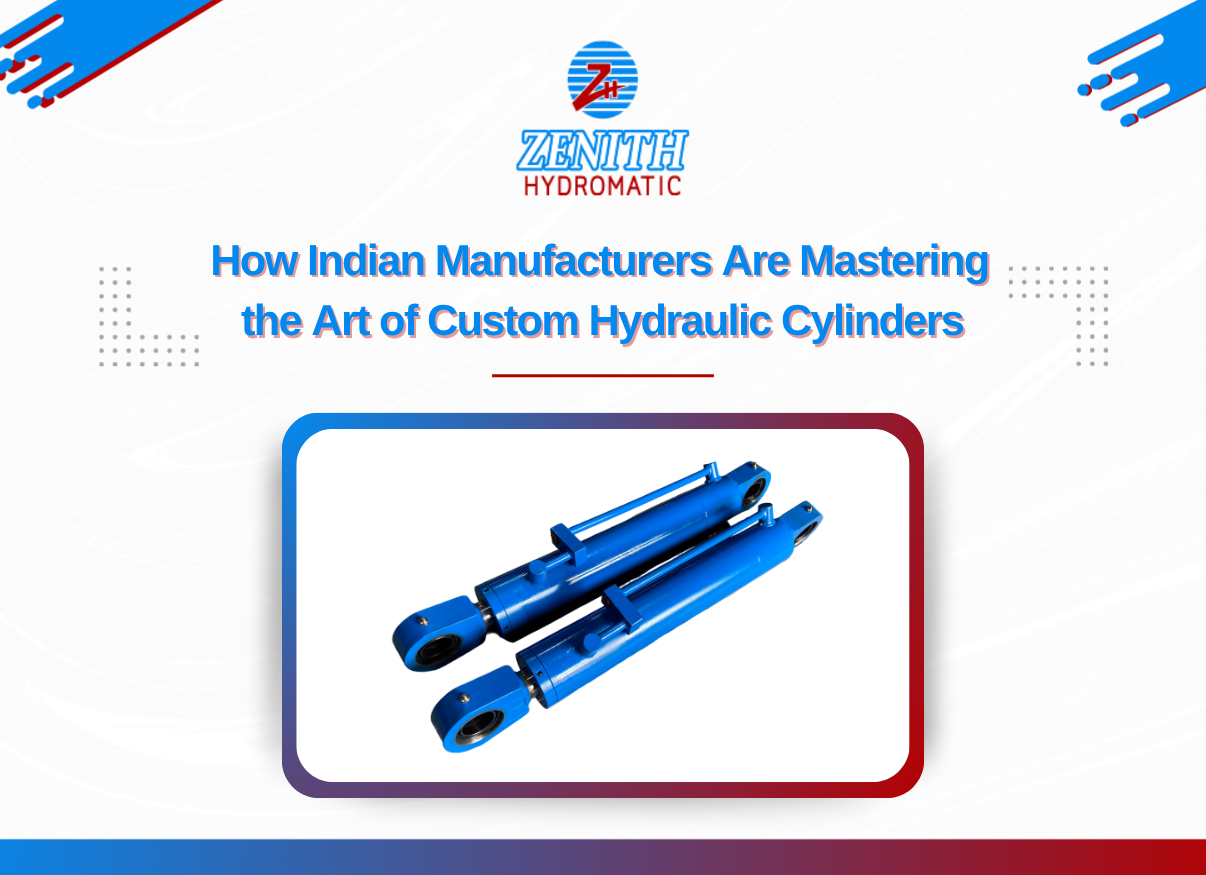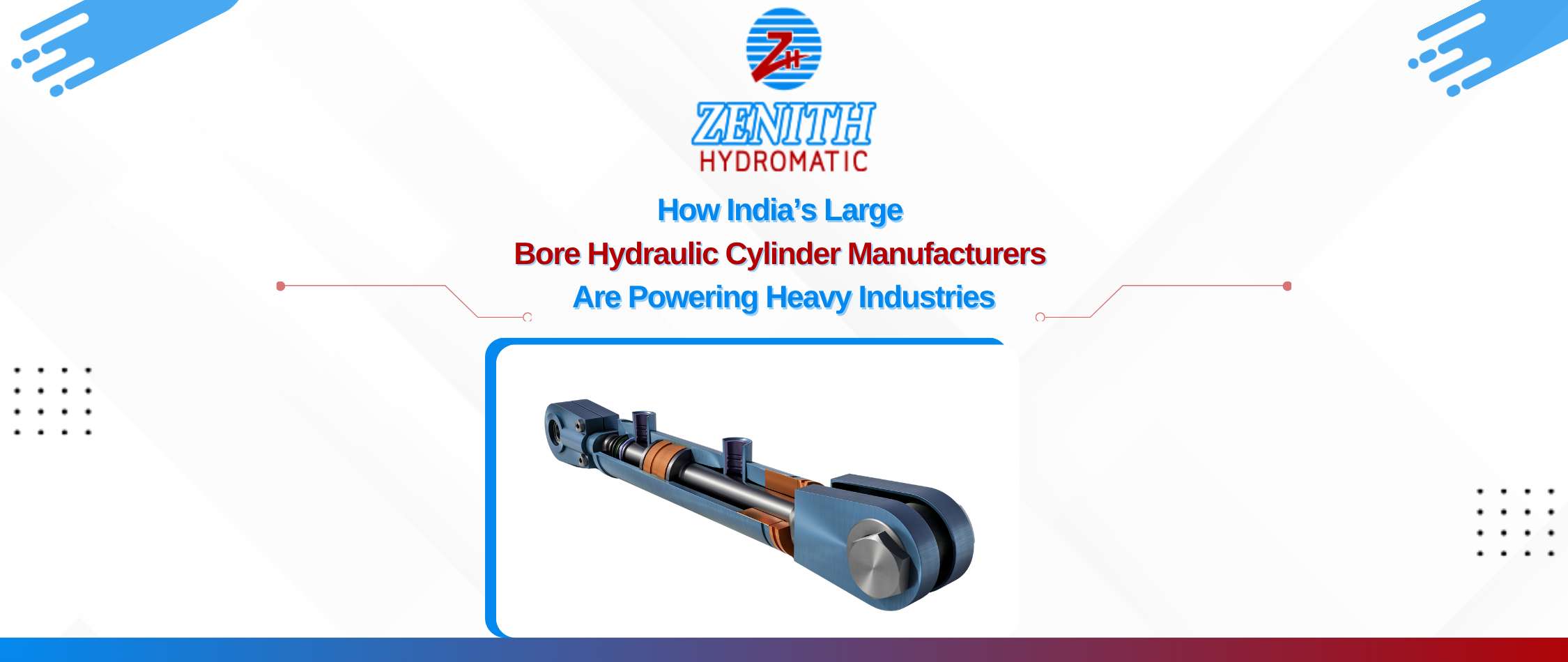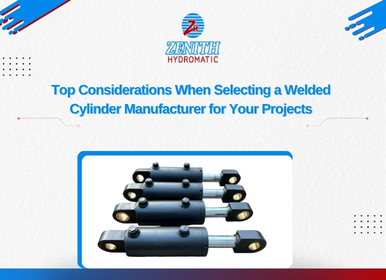
Air and gas compressors are vital to industries like manufacturing, construction, and energy. But to keep them running smoothly and efficiently, one key factor is often overlooked: proper lubrication. A well-maintained lubrication system reduces friction, controls temperature, prevents wear, and ensures long-term performance of compressor components like bearings, pistons, and rotors.
Poor lubrication is a leading cause of compressor failure. Issues such as using the wrong oil, contamination, or skipped maintenance can lead to overheating, excessive wear, and costly downtime. These failures impact not just equipment, but also energy consumption and overall productivity.
Every compressor type, rotary, reciprocating, scroll, or centrifugal, has specific lubrication needs. Managing oil quality, viscosity, and contamination is crucial for avoiding common breakdowns and improving energy efficiency.
That’s where Zenith Hydromatic steps in. As a trusted provider of industrial lubrication solutions, Zenith Hydromatic offers tailored compressor lubrication systems built for performance, reliability, and low maintenance. Backed by decades of experience, we deliver expert guidance, customized systems, and full technical support across industries.
In this blog, we’ll share 10 expert tips to improve your compressor’s lubrication efficiency, reduce costs, and extend equipment life, straight from the industry specialists at Zenith Hydromatic.
1. Choose the Right Lubricant for Your Compressor Type
Not all compressors are the same, and neither are their lubricants. Using the right oil for your compressor helps it run smoothly, last longer, and use less energy.
Here’s why it matters:
- Rotary screw compressors run constantly and get hot, so they need oil that can handle heat and won’t create foam.
- Reciprocating (piston) compressors work with strong back-and-forth motion, so they need thicker oil to protect moving parts.
- Centrifugal compressors spin very fast and don’t have as much internal friction, so they use thinner oil that flows easily and stays clean.
If you use the wrong type of lubricant, your compressor could overheat, wear out faster, or use more power. That’s why it’s important to match the oil to the type of compressor you have.When in doubt, follow the compressor manufacturer’s guidelines or get help from professionals like Zenith Hydromatic. Their team can help you pick the best compressor lubricant for your machine and working conditions—whether it’s hot, dusty, or working non-stop.
2. Monitor Oil Viscosity and Additive Breakdown
Your compressor’s oil isn’t just for lubrication—it’s a key protector of your machine. But over time, the oil changes, especially when exposed to heat, pressure, and contaminants.
Why Viscosity Matters:
Oil viscosity refers to how thick or thin the oil is. If it’s too thick, it can’t flow properly. If it’s too thin, it won’t protect the moving parts. High operating temperatures can thin out the oil, reducing its ability to protect the compressor. That’s why it’s important to regularly check the compressor oil viscosity, especially in high-heat or heavy-duty environments.
Watch for Additive Degradation:
Modern compressor oils include additives like:
- Anti-wear agents – prevent metal-to-metal contact
- Anti-foam agents – reduce bubbles that interfere with lubrication
- Antioxidants – prevent oil from breaking down over time
These additives degrade with use, especially when the compressor runs hot or operates in dusty or humid environments. As additives break down, the oil becomes less effective, leading to lubricant degradation, increased wear, and potential failure.
3. Follow a Regular Oil Change Schedule
Changing the oil in your air or gas compressor isn’t just a routine task—it’s a vital part of keeping your system running smoothly and efficiently. Without proper maintenance, even the best lubricant can degrade and cause major damage over time.
Time-Based vs. Condition-Based Oil Change Intervals
Most manufacturers recommend time-based oil change intervals, such as every 1,000 to 4,000 hours of operation. This works well for standard applications, but may not suit all systems. In more demanding environments, a condition-based schedule where oil is tested and changed based on its actual performance offers better protection and cost efficiency.
Using oil analysis tools, you can track signs of wear, oxidation, contamination, and viscosity changes. This helps you change the oil exactly when needed—not too soon, not too late.
What Accelerates Oil Breakdown?
Several factors can shorten the lifespan of compressor oil:
- High operating temperatures
- Dusty or humid environments
- Overloading the compressor
- Poor filtration or coolant failureWhen oil starts breaking down, it loses viscosity, forms sludge, and stops protecting your compressor effectively. Ignoring this can lead to wear, overheating, and energy waste.
Lubrication Maintenance Tip:
Keep a detailed log of operating hours and environmental conditions. Regular inspections and timely oil changes will maximize compressor life and minimize costly downtime.
4. Prevent Contamination in the Lubrication Circuit
Keeping your compressor’s lubrication circuit clean is essential to extending the life of your equipment. Contamination in compressor lubrication can quickly degrade the oil, damage internal components, and reduce system efficiency.
Common Contaminants That Harm Compressor Oil
Even small amounts of contamination can cause big problems. Watch out for:
- Dust and dirt: Enter through air intakes or during oil refilling
- Water or moisture: Often caused by condensation or leaky seals
- Metal particles: Resulting from internal wear and tear
These contaminants can lead to clogged filters, abrasive wear, and oil breakdown, compromising the entire lubrication system.
How to Keep Compressor Oil Clean
To avoid costly failures and ensure clean compressor oil:
- Use high-quality filters: Regularly check and replace oil and air filters
- Install desiccant breathers: Prevent moisture and airborne particles from entering the system
- Practice proper storage: Always store lubricants in sealed, clean containers away from dirt and humidity
- Follow clean refilling practices: Use clean funnels and check hoses or tanks for residue before use
Contamination control isn’t just a maintenance task—it’s a reliability strategy. Keeping your compressor oil clean means fewer breakdowns, better efficiency, and lower maintenance costs.
5. Maintain Optimal Lubricant Temperature
Proper temperature control is critical for the performance and longevity of your compressor’s lubrication system. Whether your system uses air or water cooling, maintaining ideal compressor oil temperature control helps prevent premature wear, oxidation, and system inefficiency.
Why Temperature Control Matters
Lubricants are designed to perform within a specific temperature range. If the oil becomes too hot, it can lead to:
- Faster oxidation and thickening of the oil
- Breakdown of critical additives (anti-wear, anti-foam, etc.)
- Increased sludge and varnish build-up
- Potential for component seizure or failure
On the other hand, oil that’s too cold can cause:
- Reduced flow and poor lubrication during startup
- Increased energy consumption
- Inadequate film strength to protect moving parts
This is why lubrication cooling systems, whether air-cooled or water-cooled, are essential. They help maintain a stable oil temperature, ensuring consistent performance under varying loads and ambient conditions.
Tips for Effective Temperature Control
- Regularly inspect and clean cooling systems (fans, fins, or water lines)
- Monitor oil temperature gauges closely during operation
- Choose lubricants formulated to perform well at your operating temperature range
- Ensure ventilation in compressor rooms to avoid heat buildup
With the right strategy, compressor oil temperature control becomes a key part of your maintenance program, protecting your equipment and maximizing productivity.
6. Use High-Quality Seals and Gaskets
Maintaining a reliable lubrication system goes beyond just choosing the right oil—it also depends on preventing leaks and oil bypass through durable and compatible sealing components. High-quality seals and gaskets play a critical role in keeping compressor lubrication systems clean, pressurized, and efficient.
Why Seals Matter in Compressor Lubrication
Over time, worn-out or poorly matched seals can cause serious issues like:
- Compressor oil leaks
- Air or gas leaks that reduce system efficiency
- Contaminant ingress leading to lubricant degradation
- Increased maintenance costs and equipment downtime
To avoid these problems, it’s essential to prioritize compressor oil leak prevention through regular inspection and proactive replacement of seals and gaskets.
Seal Compatibility and Material Selection
Not all seals are created equal. The material used must be compatible with your lubricant, whether you’re using synthetic or mineral oils. Some lubricants contain additives or operate at temperatures that can degrade certain rubber or polymer materials. Using seals that resist swelling, cracking, or chemical breakdown ensures long-term reliability.
Lubrication Seal Maintenance Tips
- Inspect seals and gaskets during every oil change
- Use OEM-approved or high-grade aftermarket parts
- Choose seals designed for high-temperature and high-pressure environments
- Replace seals at the first sign of wear, brittleness, or leakage
Effective lubrication seal maintenance ensures a tight, clean, and reliable system, reducing oil consumption, improving performance, and extending compressor life.
7. Perform Routine Oil Sampling and Analysis
Routine compressor oil analysis is one of the smartest and most cost-effective ways to ensure the long-term health of your air or gas compressor. Instead of waiting for problems to appear, oil sampling and testing allow you to detect early signs of system issues, helping you avoid breakdowns, reduce maintenance costs, and extend equipment life.
What Should You Test For?
A comprehensive oil analysis typically checks for:
- Wear metals: The Presence of metals like iron, copper, or aluminum can indicate internal component wear.
- Viscosity changes: A drop or rise in viscosity affects lubrication quality and could be caused by overheating, oxidation, or contamination.
- Moisture and water content: Even small amounts of water can promote rust, sludge formation, and additive depletion.
- Additive levels: Monitoring anti-wear, antioxidant, and detergent additives helps determine if the oil is still effective.
- Contaminants: Look for signs of dirt, soot, or coolant mixing with the oil.
Why It Matters
Through regular compressor oil analysis, maintenance teams can shift from reactive repairs to predictive maintenance. By catching issues like abnormal wear or oil degradation early, you can schedule corrective action before failures occur, minimizing downtime and improving productivity.
Best Practices for Predictive Maintenance
- Take oil samples regularly (monthly or quarterly, depending on usage)
- Always sample from the same location in the system
- Use clean containers and follow lab instructions carefully
- Compare results over time to spot trends
Incorporating oil analysis into your maintenance plan turns data into actionable insights, ensuring your compressor runs cleaner, longer, and more efficiently.
8. Watch for Signs of Lubrication Failure
Effective lubrication is the backbone of a well-performing compressor. But when oil begins to degrade or fail, the system will show warning signs, often before major damage occurs. Being alert to these compressor lubrication failure symptoms can help you take timely action and avoid costly repairs or downtime.
Common Signs of Oil Degradation or Failure
- Unusual Noise: Increased mechanical noise, such as knocking, grinding, or whining, may signal that the internal components are no longer receiving proper lubrication.
- Excessive Heat: A sudden spike in operating temperature could mean the lubricant is losing its viscosity, creating more friction and wear. This can lead to overheating, especially in high-speed rotary compressors.
- Pressure Drops: If your compressor struggles to maintain pressure, it could be due to internal wear from oil degradation, reducing sealing efficiency, and overall performance.
- Foam Formation: Excessive foaming is a major sign of lubrication failure. Foam reduces the lubricant’s ability to coat and protect surfaces, leading to increased wear and oxidation.
- Sludge or Varnish Buildup: Sticky residues or dark deposits in the oil reservoir or on internal parts indicate that the oil has oxidized and broken down, posing a serious risk to moving parts and filters.
What Causes These Issues?
- Extended oil life without change
- Exposure to high temperatures or contaminants
- Incompatible or poor-quality oil
- Moisture ingress or air contamination
Why It Matters
Ignoring these signs of oil degradation can lead to compressor seizure, reduced efficiency, and shortened equipment lifespan. Regular inspection and maintenance, along with timely oil analysis, can help prevent these issues before they escalate.
By staying alert to the early symptoms of lubrication failure, you can maintain compressor health, minimize unplanned shutdowns, and extend the lifespan of both oil and machine components.
9. Automate Lubrication Where Possible
In today’s fast-paced industrial environments, relying solely on manual lubrication can increase the risk of human error, missed intervals, or inconsistent oil application. That’s why many facilities are turning to automatic compressor lubrication systems to ensure reliability and efficiency across operations.
Why Automation Matters in Lubrication
Automating the lubrication process reduces downtime, enhances machine protection, and ensures that the right amount of lubricant reaches critical components at the right time. This is especially important for compressors that run continuously or are installed in hard-to-reach locations.
Centralized Lubrication Systems
Centralized systems are designed to distribute lubricant from a single pump or reservoir to multiple points in your compressor setup. These systems maintain precise flow rates and eliminate the need for manual intervention, making them ideal for large-scale operations or multi-compressor environments.
Benefits include:
- Consistent lubrication under all operating conditions
- Reduced labor and maintenance costs
- Longer equipment life and fewer failures
Smart Lubrication Monitoring with IoT and PLC Integration
Modern smart lubrication monitoring solutions use IoT sensors and PLC-integrated systems to provide real-time data on oil levels, pressure, temperature, and flow. These technologies help operators:
- Detect lubrication issues before failure
- Monitor system health remotely
- Schedule maintenance proactively based on real-time data
Stay Ahead with Smart Lubrication
Integrating automatic compressor lubrication systems with smart monitoring not only boosts efficiency but also supports predictive maintenance strategies. It’s a forward-thinking approach that aligns with Industry 4.0 and keeps your compressor systems running optimally with less guesswork.
10. Work with a Trusted Lubrication System Supplier
Choosing the right lubrication partner can make a significant difference in the performance and longevity of your compressor systems. When it comes to industrial equipment, one-size-fits-all solutions rarely deliver lasting results. That’s why it’s essential to work with an industrial lubrication system supplier that understands your specific requirements and offers tailored support.
Why Supplier Expertise Matters
An experienced partner like Zenith Hydromatic brings years of domain knowledge, engineering precision, and a deep understanding of industry-specific needs. From helping you select the right lubricant type and delivery method to designing a complete lubrication system, their guidance ensures optimal performance and reliability.
Custom Solutions for Every Application
Each industrial environment is unique—factors such as operating temperature, load conditions, compressor type, and duty cycles all influence the lubrication strategy. Zenith Hydromatic specializes in custom compressor lubrication systems that are engineered to match your equipment’s exact needs, offering:
- Correct lubricant selection (mineral or synthetic)
- Customized oil flow and delivery rates
- Integration with automation and control systems
Reliable After-Sales Support
Beyond installation, working with a trusted supplier means ongoing support. Zenith Hydromatic provides technical assistance, oil analysis services, and maintenance training to keep your systems performing at their best.
A Long-Term Lubrication Partner
Partnering with a knowledgeable industrial lubrication system supplier ensures that your compressors are protected, efficient, and compliant with modern maintenance standards. When you choose Zenith Hydromatic, you’re not just buying a product—you’re gaining a reliable partner committed to powering your productivity.
Conclusion
Efficient lubrication isn’t just a maintenance task; it’s a critical factor in the longevity and performance of your air or gas compressor. From selecting the right oil to monitoring viscosity, preventing contamination, and automating lubrication systems, each step helps reduce downtime, extend component life, and improve energy efficiency.
At Zenith Hydromatic, we go beyond just supplying lubrication systems; we offer tailor-made, application-specific solutions backed by years of industry experience. Whether you’re running a rotary screw compressor in a manufacturing unit or managing a fleet of reciprocating compressors in a processing plant, our expert team ensures you get the right lubrication strategy for maximum reliability.
👉 Need help optimizing your compressor lubrication system?
Contact Zenith Hydromatic today for expert consultation and custom solutions built to power your productivity.
FAQs
1. What is the ideal oil change interval for screw compressors?
The ideal oil change interval for screw compressors typically ranges from 2,000 to 8,000 operating hours, depending on the type of lubricant (mineral or synthetic), operating conditions, and manufacturer recommendations. Condition-based monitoring—like oil analysis—is ideal for extending service life without risking equipment damage.
2. Can I use the same lubricant for different compressor types?
Not always. Each compressor type (rotary screw, reciprocating, centrifugal) has different operating temperatures, speeds, and pressure loads. It’s essential to choose a lubricant formulated specifically for your compressor’s design to ensure proper viscosity, protection, and performance.
3. What are the signs of lubricant contamination?
Common signs of contamination include cloudy or milky oil (water contamination), unusual odor, presence of sludge or particles, and increased operating temperature or noise. Contaminated oil can reduce efficiency and accelerate wear, so regular oil sampling and filtration are critical.
4. How does temperature affect compressor lubrication?
Temperature directly affects oil viscosity and additive stability. Too high, and the oil thins out—reducing film strength and protection. Too low, and the oil becomes thick, hindering flow and increasing startup wear. Proper cooling and temperature control are essential for maintaining lubricant effectiveness.
5. Do I need different oils for oil-free vs. oil-lubricated compressors?
Yes. Oil-lubricated compressors require specially formulated lubricants to reduce friction and carry away heat. In contrast, oil-free compressors use lubricants only in limited components like gearboxes or bearings and often require non-contaminating, food-grade, or specialty lubricants for those parts.



